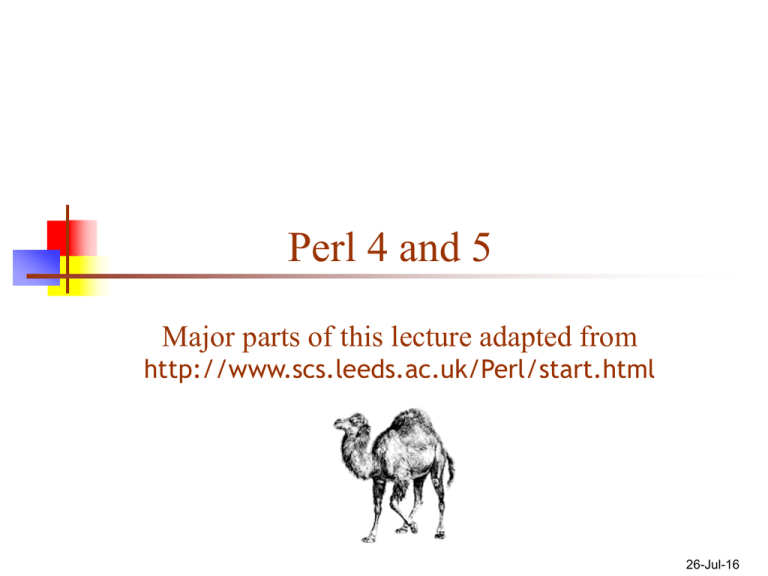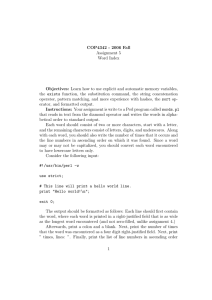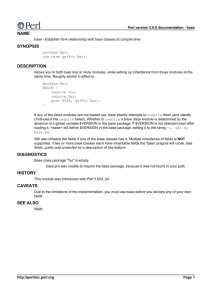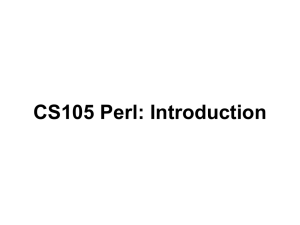Perl 4 and 5 Major parts of this lecture adapted from 26-Jul-16
advertisement

Perl 4 and 5
Major parts of this lecture adapted from
http://www.scs.leeds.ac.uk/Perl/start.html
26-Jul-16
Why Perl?
Perl is built around regular expressions
REs are good for string processing
Therefore Perl is a good scripting language
Perl is especially popular for CGI scripts
Perl makes full use of the power of UNIX
Short Perl programs can be very short
“Perl is designed to make the easy jobs easy, without
making the difficult jobs impossible.” -- Larry Wall,
Programming Perl
2
Why not Perl?
Perl is very UNIX-oriented
Perl does not scale well to large programs
Perl is available on other platforms...
...but isn’t always fully implemented there
However, Perl is often the best way to get some UNIX
capabilities on less capable platforms
Weak subroutines, heavy use of global variables
Perl’s syntax is not particularly appealing
3
What is a scripting language?
Operating systems can do many things
copy, move, create, delete, compare files
execute programs, including compilers
schedule activities, monitor processes, etc.
A command-line interface gives you access to these
functions, but only one at a time
A scripting language is a “wrapper” language that
integrates OS functions
4
Major scripting languages
UNIX has sh, Perl
Macintosh has AppleScript, Frontier
Windows has no major scripting languages
probably due to the weaknesses of DOS
Generic scripting languages include:
Perl (most popular)
Tcl (easiest for beginners)
Python (new, Java-like, best for large programs)
5
Perl Example 1
#!/usr/local/bin/perl
#
# Program to do the obvious
#
print 'Hello world.';
# Print a message
6
Comments on “Hello, World”
Comments are # to end of line
But the first line, #!/usr/local/bin/perl, tells where to find
the Perl compiler on your system
Perl statements end with semicolons
Perl is case-sensitive
Perl is compiled and run in a single operation
7
Perl Example 2
#!/ex2/usr/bin/perl
# Remove blank lines from a file
# Usage: singlespace < oldfile > newfile
while ($line = <STDIN>) {
if ($line eq "\n") { next; }
print "$line";
}
8
More Perl notes
On the UNIX command line;
In Perl, <STDIN> is the input file, <STDOUT> is the output file
Scalar variables start with $
Scalar variables hold strings or numbers, and they are
interchangeable
Examples:
< filename means to get input from this file
> filename means to send output to this file
$priority = 9;
$priority = '9';
Array variables start with @
9
Perl Example 3
#!/usr/local/bin/perl
# Usage: fixm <filenames>
# Replace \r with \n -- replaces input files
foreach $file (@ARGV) {
print "Processing $file\n";
if (-e "fixm_temp") { die "*** File fixm_temp already exists!\n"; }
if (! -e $file) { die "*** No such file: $file!\n"; }
open DOIT, "| tr \'\\015' \'\\012' < $file > fixm_temp"
or die "*** Can't: tr '\015' '\012' < $infile > $outfile\n";
close DOIT;
open DOIT, "| mv -f fixm_temp $file"
or die "*** Can't: mv -f fixm_temp $file\n";
close DOIT;
}
10
Comments on example 3
In # Usage: fixm <filenames>, the angle brackets just
mean to supply a list of file names here
In UNIX text editors, the \r (carriage return) character
usually shows up as ^M (hence the name fixm_temp)
The UNIX command tr '\015' '\012' replaces all \015
characters (\r) with \012 (\n) characters
The format of the open and close commands is:
open fileHandle, fileName
close fileHandle, fileName
says: Take input from
$file, pipe it to the tr command, put the output on
"| tr \'\\015' \'\\012' < $file > fixm_temp"
fixm_temp
11
Arithmetic in Perl
$a = 1 + 2;
$a = 3 - 4;
$a = 5 * 6;
$a = 7 / 8;
$a = 9 ** 10;
$a = 5 % 2;
++$a;
$a++;
--$a;
$a--;
# Add 1 and 2 and store in $a
# Subtract 4 from 3 and store in $a
# Multiply 5 and 6
# Divide 7 by 8 to give 0.875
# Nine to the power of 10, that is, 910
# Remainder of 5 divided by 2
# Increment $a and then return it
# Return $a and then increment it
# Decrement $a and then return it
# Return $a and then decrement it
12
String and assignment operators
$a = $b . $c; # Concatenate $b and $c
$a = $b x $c; # $b repeated $c times
$a = $b;
$a += $b;
$a -= $b;
$a .= $b;
# Assign $b to $a
# Add $b to $a
# Subtract $b from $a
# Append $b onto $a
13
Single and double quotes
$a = 'apples';
$b = 'bananas';
print $a . ' and ' . $b;
print '$a and $b';
prints: apples and bananas
prints: $a and $b
print "$a and $b";
prints: apples and bananas
14
Arrays
@food = ("apples", "bananas", "cherries");
But…
print $food[1];
@morefood = ("meat", @food);
prints "bananas"
@morefood ==
("meat", "apples", "bananas", "cherries");
($a, $b, $c) = (5, 10, 20);
15
push and pop
push adds one or more things to the end of a list
pop removes and returns the last element
push (@food, "eggs", "bread");
push returns the new length of the list
$sandwich = pop(@food);
$len = @food; # $len gets length of @food
$#food # returns index of last element
16
foreach
# Visit each item in turn and call it $morsel
foreach $morsel (@food)
{
print "$morsel\n";
print "Yum yum\n";
}
17
Tests
“Zero” is false. This includes:
0, '0', "0", '', ""
Anything not false is true
Use == and != for numbers, eq and ne for strings
&&, ||, and ! are and, or, and not, respectively.
18
for loops
for loops are just as in C or Java
for ($i = 0; $i < 10; ++$i)
{
print "$i\n";
}
19
while loops
#!/usr/local/bin/perl
print "Password? ";
$a = <STDIN>;
chop $a;
# Remove the last character (\n)
while ($a ne "fred")
{
print "sorry. Again? ";
$a = <STDIN>;
chop $a;
}
20
do..while and do..until loops
#!/usr/local/bin/perl
do
{
print "Password? ";
$a = <STDIN>;
chop $a;
}
while ($a ne "fred");
21
if statements
if ($a)
{
print "The string is not empty\n";
}
else
{
print "The string is empty\n";
22
if - elsif statements
if (!$a)
{ print "The string is empty\n"; }
elsif (length($a) == 1)
{ print "The string has one character\n"; }
elsif (length($a) == 2)
{ print "The string has two characters\n"; }
else
{ print "The string has many characters\n"; }
23
Why Perl?
Two factors make Perl important:
Pattern matching/string manipulation
Based on regular expressions (REs)
REs are similar in power to those in Formal Languages…
…but have many convenience features
Ability to execute UNIX commands
The Perl interpreter emulates these commands on nonUNIX platforms
Often Perl is used simply for its UNIX emulation
24
Basic pattern matching
$sentence =~ /the/
$sentence = "The dog bites.";
if ($sentence =~ /the/) # is false
True if $sentence contains "the"
…because Perl is case-sensitive
!~ is "does not contain"
25
RE special characters
.
# Any single character except a newline
^
# The beginning of the line or string
$
# The end of the line or string
*
# Zero or more of the last character
+
# One or more of the last character
?
# Zero or one of the last character
26
RE examples
^.*$
# matches the entire string
hi.*bye
# matches from "hi" to "bye" inclusive
x +y
# matches x, one or more blanks, and y
^Dear
# matches "Dear" only at beginning
bags?
# matches "bag" or "bags"
hiss+
# matches "hiss", "hisss", "hissss", etc.
27
Square brackets
[qjk]
# Either q or j or k
[^qjk]
# Neither q nor j nor k
[a-z]
# Anything from a to z inclusive
[^a-z]
# No lower case letters
[a-zA-Z] # Any letter
[a-z]+
# Any non-zero sequence of
# lower case letters
28
More examples
[aeiou]+
# matches one or more vowels
[^aeiou]+ # matches one or more nonvowels
[0-9]+
# matches an unsigned integer
[0-9A-F]
# matches a single hex digit
[a-zA-Z]
# matches any letter
[a-zA-Z0-9_]+ # matches identifiers
29
More special characters
\n
\t
\w
\W
\d
\D
\s
\S
\b
\B
# A newline
# A tab
# Any alphanumeric; same as [a-zA-Z0-9_]
# Any non-word char; same as [^a-zA-Z0-9_]
# Any digit. The same as [0-9]
# Any non-digit. The same as [^0-9]
# Any whitespace character
# Any non-whitespace character
# A word boundary, outside [] only
# No word boundary
30
Quoting special characters
\|
\[
\)
\*
\^
\/
\\
# Vertical bar
# An open square bracket
# A closing parenthesis
# An asterisk
# A carat symbol
# A slash
# A backslash
31
Alternatives and parentheses
jelly|cream # Either jelly or cream
(eg|le)gs
# Either eggs or legs
(da)+
# Either da or dada or
# dadada or...
32
Substitution
=~ is a test, as in: $sentence =~ /the/
!~ is the negated test, as in:
$sentence !~ /the/
=~ is also used for replacement, as in:
$sentence =~ /london/London/
This is an expression, whose value is the number of
substitutions made (0 or 1)
33
The $_ variable
Often we want to process one string repeatedly
The $_ variable holds the current string
If a subject is omitted, $_ is assumed
Hence, the following are equivalent:
if ($sentence =~ /under/) …
$_ = $sentence; if (/under/) ...
34
Global substitutions
s/london/London/
s/london/London/g
substitutes London for the first occurrence of london in $_
substitutes London for each occurrence of london in $_
The value of a substitution expression is the number of
substitutions actually made
35
Case-insensitive substitutions
s/london/London/i
case-insensitive substitution; will replace london, LONDON,
London, LoNDoN, etc.
You can combine global substitution with caseinsensitive substitution
s/london/London/gi
36
Remembering patterns
Any part of the pattern enclosed in parentheses is
assigned to the special variables $1, $2, $3, …, $9
Numbers are assigned according to the left (opening)
parentheses
"The moon is high" =~ /The (.*) is (.*)/
Afterwards, $1 = "moon" and $2 = "high"
37
Dynamic matching
During the match, an early part of the match that is
tentatively assigned to $1, $2, etc. can be referred to by
\1, \2, etc.
Example:
\b.+\b matches a single word
/(\b.+\b) \1/ matches repeated words
"Now is the the time" =~ /(\b.+\b) \1/
Afterwards, $1 = "the"
38
tr
tr does character-by-character translation
tr returns the number of substitutions made
$sentence =~ tr/abc/edf/;
$count = ($sentence =~ tr/*/*/);
replaces a with e, b with d, c with f
counts asterisks
tr/a-z/A-Z/;
converts to all uppercase
39
split
split breaks a string into parts
$info = "Caine:Michael:Actor:14, Leafy Drive";
@personal = split(/:/, $info);
@personal =
("Caine", "Michael", "Actor", "14, Leafy Drive");
40
Associative arrays
Associative arrays allow lookup by name rather than
by index
Associative array names begin with %
Example:
%fruit = ("apples", "red", "bananas", "yellow",
"cherries", "red");
Now, $fruit{"bananas"} returns "yellow"
Note: braces, not parentheses
41
Associative Arrays II
Can be converted to normal arrays:
@food = %fruit;
You cannot index an associative array, but you can use
the keys and values functions:
foreach $f (keys %fruit)
{
print ("The color of $f is " .
$fruit{$f} . "\n");
}
42
Associative Arrays III
The function each gets key-value pairs
while (($f, $c) = each(%fruit))
{
print "$f is $c\n";
}
43
Calling subroutines
Assume you have a subroutine printargs that just
prints out its arguments
Subroutine calls:
&printargs("perly", "king");
Prints: "perly king"
&printargs("frog", "and", "toad");
Prints: "frog and toad"
44
Defining subroutines
Here's the definition of printargs:
sub printargs
{ print "@_\n"; }
Where are the parameters?
Parameters are put in the array @_
@_ has nothing to do with $_ ; they are unrelated
45
Returning a result
The value of a subroutine is the value of the last
expression that was evaluated
sub maximum
{
if ($_[0] > $_[1])
{ $_[0]; }
else
{ $_[1]; }
}
$biggest = &maximum(37, 24);
46
Local variables
@_ is local to the subroutine, and…
…so are $_[0], $_[1], $_[2], …
local creates local variables
47
Example subroutine
sub inside
{
local($a, $b);
($a, $b) = ($_[0], $_[1]);
$a =~ s/ //g;
$b =~ s/ //g;
($a =~ /$b/ || $b =~ /$a/);
}
&inside("lemon", "dole money");
# Make local variables
# Assign values
# Strip spaces from
#
local variables
# Is $b inside $a
#
or $a inside $b?
# true
48
Perl 5
Perl 5 is usually described as “a whole new language”
However, Perl 5 is mostly backward compatible, and there are only a few
apparent differences
Perl 4 had three types of data: $scalar , @array, and %hash
Perl 5 adds another item: the reference
References are indicated by \
Perl 5 interpolates arrays into double-quoted strings
Perl 5 provides reluctant quantifiers (with ?)
Perl 5 has modules, which are similar to classes
The most significant difference is that Perl can now be written in a more
object-oriented fashion (like C++ compares to C)
Perl now provides a handful of modules (just as Java has always provided
prewritten classes)
Perl 5 has “auto” variables
Variables may now be declared within a lexical scope
49
Perl 6
Whereas Perl 5 is often described as “a whole new
language,” Perl 6 is a whole new language
The best summary of the differences that I’ve found is
http://perlcabal.org/syn/Differences.html
Perl 6 status: Vaporware
Larry Wall: “We're working on it, slowly but surely...or notso-surely in the spots we're not so sure...”
Just interesting reading: An interview with Larry Wall:
http://lwn.net/2001/features/LarryWall/
50
The End
51


